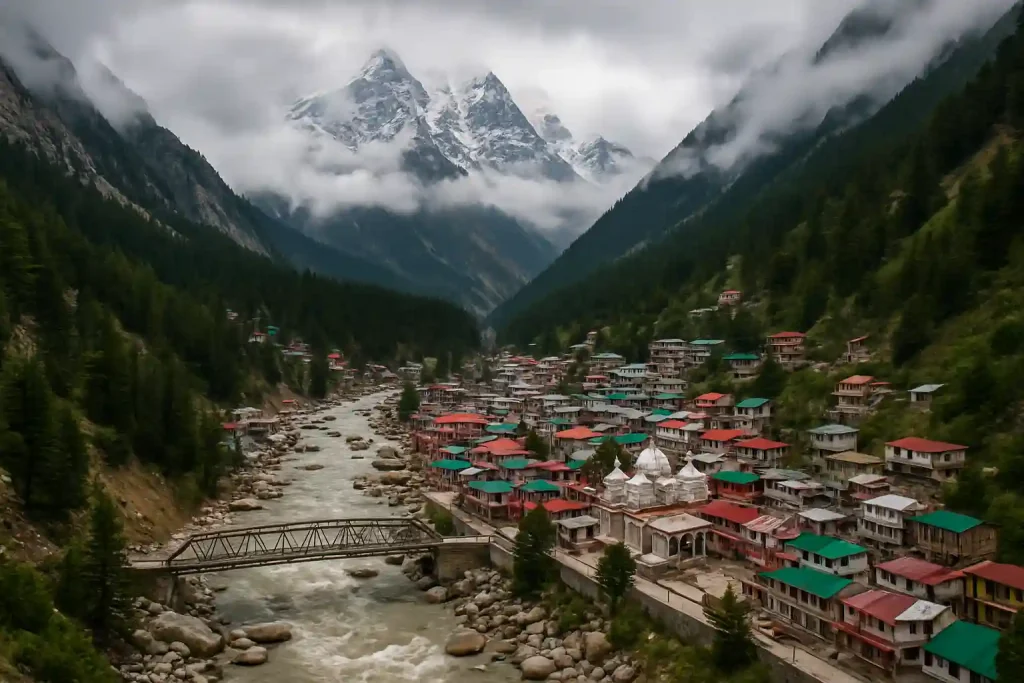Up in the mountains, Gangotri offers something special to everyone — peace for those who come with prayers and a sense of adventure for those who love the outdoors. But the mountains are not the kind of place you visit without thought. The time you choose to come here can change your whole experience. Pick the right season, and the journey feels smooth and beautiful. Pick the wrong one, and it may become harder than you hoped. In this blog, I’ll share everything in simple words — when it feels best to travel, what you can expect there, and a few small tips that can make your visit calmer and more meaningful. And if you are planning a spiritual trip, you can also take a look at our helicopter packages for the Char Dham and Do Dham Yatra.

Where and Why Gangotri is Unique
Gangotri is a small mountain town in Uttarakhand, hidden so high in the Himalayas that it feels like another world. This is where the Ganga takes her very first step into the land below. The river here is still wild and young — so cold it stings your fingers, so powerful that its sound fills the whole valley. The temple of Goddess Ganga stands right beside it, and the prayers seem to rise with the river’s flow. People come for many reasons. Some arrive quietly, carrying wishes in their hearts. Others just want to be with the mountains — to walk along the rough stones, breathe air that feels new, and sit near the water without needing a single word. And some continue their journey further up, to Gomukh, to see the river appear from the ice, like a secret being revealed slowly by nature.
But the mountains can change their mood in a moment. A warm patch of sunshine can disappear under a sprinkle of snow. The wind can turn sharp without warning. Roads slow down, and you learn to move only as fast as the mountains allow. That’s why the time you choose to come matters more than any packing list. And if you dream of trekking up to Gomukh, or visiting Yamunotri along with Gangotri, choosing the right moment can make everything easier. When the season is right, the journey feels like a blessing — not a battle. Ahead, we’ll talk about the months when the mountains open their arms a little wider, so your memories of this place are made of peace, not difficulty.
Seasons at Gangotri
Let us look at the year season-wise to know when is auspicious:
- Winter (November to mid-March)
- Spring / Pre-Monsoon (late March to May)
- Monsoon (June to mid-September)
- Post-Monsoon / Autumn (late September to October)
Every season is, after all, its own set of pros and cons.
Winter (November to Mid-March)
- Weather & Conditions: Freezing, snowstorm, normal roads closed. The temperature goes frosty, particularly at night.
- Advantages: If you like snow, winter scenery, calmness, and privacy, this time is magical. The atmosphere is white and peaceful.
- Cons: Most locations (roads, guest houses) are closed. Gomukh trekking is not practical. The temple will be difficult to enter. Danger of snowslide or snowstorm.
For most people, winter is not ideal. If you go at this time, be prepared in advance. This is also not often considered the best time for a first trip to Gangotri.
Spring / Pre-Monsoon (Late March to May)
- Weather & Conditions: Weather starts warming up. Snow still in upper reaches. Nature starts getting active. Skies clear mostly, moderate routes become feasible.
- Pros: Better views, fewer tourists compared to summer. A good time to begin trekking. Temple is easier to approach. Spring comes in a close second as the second most suitable time of the year to visit Gangotri.
- Cons: Still very cold early in spring. Late spring, occasional sudden snow or rain.
If you are planning to visit Gangotri and Yamunotri both, spring or early summer provides more flexibility. Between stops, treks are not so restricted, and moving is not so difficult.
Monsoon (June to Mid-September)
Weather & Conditions: Heavy monsoon, earthfall hazard, wet roads. Clouds can reduce visibility. Routes to Gomukh are risky.
Pros: Fewer tourists, colorful valleys, waterfalls around each corner. If you hike in the rain daily and don’t object to solitude, you may enjoy it.
Cons: Extremely high risk. Trekkers will most likely be shut. Roads get devastated or congested. Not safe in large parts. Monsoon season isn’t normally accounted for when people talk about when to visit Gangotri.
Post-Monsoon / Autumn (Late September to October)
Weather & Conditions: Rain comes to an end. Snow is not yet too heavy. Blue clear sky. Comfortable temperature. Trails remain open. Views are clear.
Advantages: This is usually the best season. Scenic views, settled weather, less clouds. Ideal for a trek to Gomukh. Ideal for the journey between Gangotri and Yamunotri.
Disadvantages: Nights may become chilly. Snow may arrive in late October or November. Selection of places to stay reduces closer to winter.
So When is the Best Time to Visit Gangotri?
Combining all these together, if anyone asks, “What is the best season to visit Gangotri?”, I would answer:
- Late April to early June (spring to early summer)
- Late September to early October (post-monsoon / autumn)
Both of these are generally the best time to go to Gangotri. Weather is settled, roads are free from snow, sky is blue, and nature is at its peak.
If you also wish to travel to Gomukh, then the late spring (May) or early autumn (September) would be ideal. That is the ideal time to visit Gangotri Gomukh. It is then snowmelted enough so that you can travel safely.
If your itinerary incorporates both Gangotri and Yamunotri, attempt to choose late April-May or September. That provides the most probable clear trails and safe journey. That’s the most suitable time for Gangotri and Yamunotri visit.
What to Expect in Different Months in Gangotri
Here is a month-wise look, with what you should expect, so you can plan well:
| Month | What to Expect | Good or Not for Visit |
| March | Snow melting starts, paths still blocked, cold | Not the best, but for hardy travellers |
| April | Snow reduces, weather improves, lovely flowers | Very good – early window for best time to visit Gangotri |
| May | Warm days, good trekking, Gomukh path opens | Excellent time – one of the best for best time to visit Gangotri Gomukh |
| June | Approaching monsoon, heat in lower parts, rains start later | Good early, but risk increases |
| July, August | Full monsoon, road blockage, landslides, clouds | Not recommended – rarely in “best time” lists |
| September | Rain subsides, cool and clear, views excellent | Excellent – top choice for best time to visit Gangotri and Gangotri best time to visit |
| October | Cold nights, possible early snow, but good days | Very good – start of winter window, still good for best time to visit Gangotri and Yamunotri |
| November-Mid-March | Snow, many closures, harsh cold | Only for very special trips or locals |
Tips for Planning Your Trip to Gangotri
Here are some tips which will make your journey smooth:
- Check road conditions in advance
Roads to Gangotri tend to get blocked in winter. Even during monsoon, landslides can cut off roads. Look for local newspaper reports before you go.
- Acclimatize
In high altitude, acclimatize. Do not try to push yourself from low to high altitude suddenly; rest at Uttarkashi or any other middle-altitude locations for a day or two.
- Clothing
Pack layers. Morning and evening warm clothes. Raingear in monsoon. Sun protection spring and autumn.
- Stay options
Peak season (late April-May, Sept-Oct), guesthouses and hotels may be full. Book in advance. Monsoon or winter, many places will be shut.
- Health safety
There is altitude sickness. Drink plenty of water. Rest days. If sick, descend to lower altitude.
- Packing essentials
Water, snacks, flashlight, first aid, waterproof shoes, warm gloves, and sunscreen.
- Permits and permissions
Sometimes for trekking to Gomukh or further on, permissions might be needed. Check with the local authorities before starting.
Personal Story: Why These Times Feel Magical
I had traveled to Gangotri in late September once. The sky was a dark blue color. The air was cold but not freezing. Walking every day wasn’t difficult. At dawn, the initial rays illuminated the summits with golden hues. Rivers and clouds at dusk were aglow. The routes leading to Gomukh were not closed off, but little snow blocked them. Quiet. Fewer human beings. That was probably the best time of year to go to Gangotri Gomukh for me.
Another trip I did was in May. Nature was reviving. Rivers thawed, flowers bloomeded. Birds made sweet songs. Trails were fine. Weather was bountiful. Even at night, it was chilly, but endurable. This was obviously within the window of the optimal time to visit Gangotri and Yamunotri, since I had already gone there.
Making the Most of Your Visit to Gangotri
When you are at the right time to tour Gangotri, do the following:
- Temple exploring: See the Gangotri temple in the early morning to experience the peace.
- Gomukh trek: If the weather looks okay, you can trek to Gomukh. The view there is amazing of the glacier.
- Nature walks: Take walks along some nearby trailsin nature. Forests, grasslands, rivers, mountain scenery are beautiful in autumn or late spring.
- Photography: For good clear pictures, the weather is ideal in September and May. So pack a good camera or phone.
- Cultural experience: Socialize with locals, eat local cuisine, go to the prayers, relish mountain hospitality.
What to Avoid and Why
Knowing what not to do makes your trip trouble-free. If you are prepared, you might get yourself into trouble.
- Avoid visiting during heavy monsoon—roads get treacherous, views are veiled over, most amenities shut.
- Avoid the entire winter if you are not used to cold, snow, or hilly travel.
- Avoid late October-November if snow has already begun; roads become treacherous.
- Do not neglect symptoms of altitude sickness.
Summary: When is Best Time to Visit Gangotri
To summarize in simple points:
- Gangotri is best visited between April-May and September and October.
- For Gomukh trekking, the same windows hold—best chances are in September or May. That is best time to observe Gangotri Gomukh.
- If you will also travel to Yamunotri, choose spring (April-May) or autumn (September-October). That is best time to see Gangotri and Yamunotri.
- If you have to pick one time, then I would suggest September. Air is clean, weather stable, roads completely open, and views majestic.
Last Word
Gangotri is a peaceful land, spiritual energy, charm, and challenge. Choosing the most apt time to go to Gangotri in advance is the secret to enjoying it safely and in full. Whether pilgrimage, trekking, or simply relishing mountain air is your ambition, the right time has everything falling into place.
Remember:
Spring and autumn are friends.
Monsoon and winter are perilous and shut.
Plan, pack with sense, and listen to your body.
Whatever be your destination, whether only Gangotri, or Gomukh, or both Gangotri and Yamunotri, respect nature. Do not carry anything with you. Be nice to locals. Enjoy each morning and each river sound.
If you are doing what is being suggested here, you will definitely be able to experience the real magic of Gangotri. The voice of the mountain, the snow mirror, the voice of the river will be with you for the rest of your life and you will know that you arrived at the right time to see Gangotri. If you are planning a spiritual trip, you can also take a look at our helicopter packages for the Char Dham and Do Dham Yatra.


